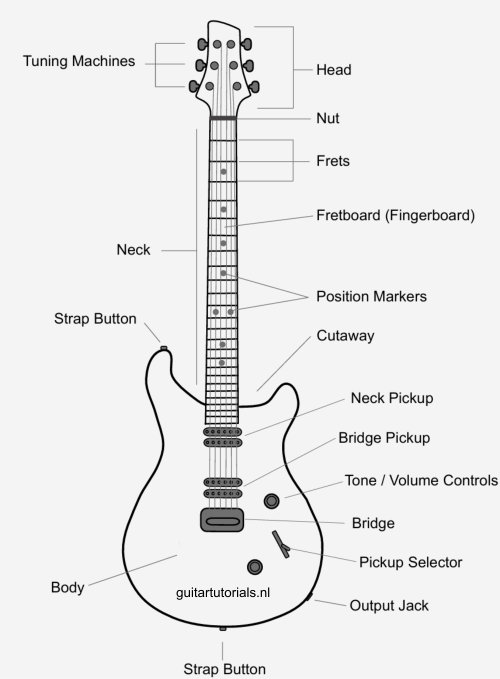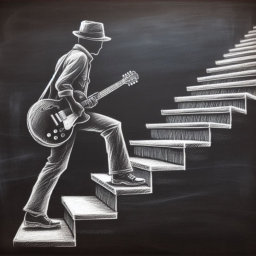
home \ tutorials \ Anatomy of the electric guitar
Tutorial: Anatomy of the Electric Guitar
Electric guitars come in many different types and shapes. However, the main building blocks are similar. The names of the parts that are also present on accoustic guitars are the same. The image below shows the most important components.

Head & tuning machines
The head is where the tuning machines are placed. At most guitars you’ll find a unique serial number
at the back of the head, and a nice shiny logo at the front. Often it is part of the unique styling of a
guitar, you can easily see the difference between a Fender Stratocaster, Telecaster, Gibson Les Paul,
Ibanez or Paul Reed Smith just by looking at the head.
It is also the place where a truss-rod cover can be found. When you dismount it (which you shouldn’t!),
you will see the ending of the truss-rod. Some guitars do not have a cover, you can see the truss-rod
directly. The truss-rod is a steel bar/rod that runs inside the neck. It takes care of the curvature of the
neck. Don’t play with the truss-rod unless you really know what you are doing, it can really mess up (or completely destroy)
your guitar!
Nut
The nut is an important part of the guitar. It is one of the few places where the strings are in direct contact with the guitar. Its purpose is to keep the string in place. For that purpose it has notches. When the notches are too rough, you might get in trouble when tuning your guitar. After bending a string, or after using your tremolo, your string might get out of tune. To solve this you can use graphite powder, or a commercial product like Big Bends Nut Sauce to smoothen the notches. Or you can have your nut replaced by a better one.
Neck
The neck is the domain of your left hand. Necks come in many different sizes. The length, width and height differ. Necks can be made from different kinds of wood, with different finish. A shorter neck means that the frets are placed closer to each other, which has impact on the playability. A wider neck means there is more space between the strings. A smooth finish will speed you up, while maybe a more rough finish will give you a better feel. Which type of neck suits you best is a personal choice. You can only find out by trying many different ones.
Fretboard, Frets & Position Markers
When you would practice a single scale with sixteenth at a speed of 120 BPM (Beats Per Minute) for
one hour, you would hit a single fret more than 4000 times. Imagine how many times you will hit a fret
in …let’s say ten years! The fretboard must be made of a very firm, high quality wood. Most fretboards
are made from Rosewood, Maple or Ebony.
The fretboard contains 22 to 24 frets. Each fret stands for a half note, so 24 frets stand for two octaves.
The frets are the little metal bars that are places perpendicular on the neck. Note however that when
we talk about the “third fret”, we don’t mean the third metal bar, but the space between the second
and third bar.
The fretboard with its 22 to 24 frets and six strings creates a surface with 6 x 22 or 6 x 24 = 132 to
144 places where you can place one of your left hand’s fingers. This matrix with 144 possibilities can
be a bit overwhelming for your eyes. To make life easier, position markers are placed. Normally they
are placed at the 3rd, 5th, 7th, 9th, 12th 15th, 17th, 19th and 21st fret (and on the 24th if it exists).
The one on the twelfth fret looks different (mostly doubled). Also, at the side of the neck little dots
are placed at the same positions. This all makes it easier for you to determine the position of your
left hand. Another advantages of position markers is that they can look really nice.
Cutaway
The cutaway is the area that does not exist… because it was cut away. It is some extra space for your left hand, to reach the high notes. Some guitars have a double cutaway, at both sides of the neck, others only have one, some have none. Best examples to compare are the Gibson Les Paul model versus the Fender Stratocaster. The first has a single cutaway, the second one a double. Classical accoustic guitars have no cutaway.
Bridge
The bridge is one of the other points where there is direct contact between the strings and the guitar. The other points are the nut, the tuning mechanics, and of course the fretboard when you press your finger on a string. At most guitars you will find some mechanics on the bridge that you can use to slightly adjust the length of your strings. This may be necessary when your guitar gets out of tune when you play higher notes. It’s best to have this string length adjusted by a professional, once every few years
Volume and tone control
These controls allow you to adjust the volume and tone of your guitar without having to adjust the controls on your amplifier. Some guitars have special knobs that you can pull out or press. By doing so you change the configuration of your pickups. If you have such knobs, read your guitar's manual to find out more.
Pickup switcher
The active pickup can be selected with the pickup switch. Normally the switch allows you to activate one or both. There is no option to switch them all off.
Output Jack
This is where you put your cable in. It is a fragile area, that can create a lot of unwanted noise when your cable is of poor quality. Never push in or pull out a cable when the amplifier is switched on: it will create an awful noise. To prevent your cable from being pulled off unwanted (e.g. because you step on it) you can guide your cable via your guitar strap at the right side of your guitar.
Body
There is much discussion about how the shape and the material used for the body affects the sound
of a guitar. Some people state that it’s crucial, others oppose that it are only the pickups that make
the sound. In the end it is the result that matters. If a guitar sounds good it is not so important what it
makes sound good (unless you want to build your own guitar…). However, there are some things to
take into account. First the shape of the body. It must feel good to hold your guitar and to have it hang
on your own body. Some guitars are more ergonomic than others. Second, the weight of the guitar.
Do you want to feel the weight, or don’t you? That’s personal, but the wood used and the size of the
body will affect this.
What does make a huge difference in sound is if you have a solid, or holow body. Holow body guitars have a warmer sound, often used in jazz. Solid body guitars are more suitable for rock.
Strap buttons
You don’t want to carry the weight of your guitar with your hands and play it at the same time. That would be almost impossible. What you need is a guitar strap. And that strap must be attached to your guitar. Your strap should be tightly attached to the strap buttons, to prevent your guitar from falling. That may sound obvious .. do a YouTube search on “Guitar Strap Fail” to learn that many guitarists didn’t get that lesson…

Everything on guitartutorials.nl is completely free to access. If you’d like to support my work and help keep this resource growing, any and all donations are deeply appreciated. Thank you, and happy playing!